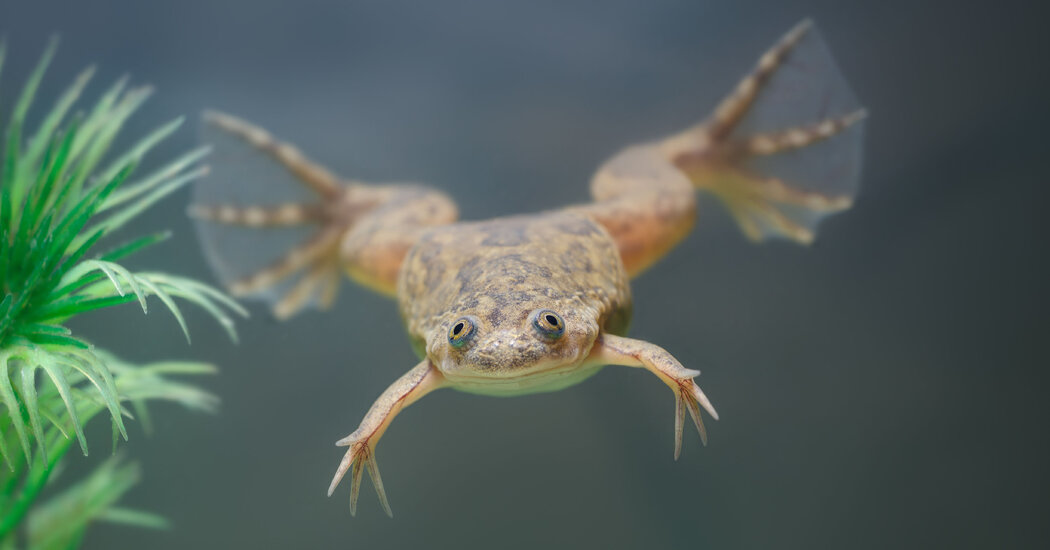Scientists describe a process by which African clawed frogs can regrow an imperfect but functional lost limb.
African clawed frogs are masters of putting themselves back together, handily regenerating lost tails and hind limbs, when they are tadpoles. But these powers dim with maturity. Wait for an adult frog to regrow a lopped-off limb and you’ll see only a tapered spike, more like a talon than a leg.
Now, a group of scientists have found a way to harness the adult frog’s own cells to regrow an imperfect but functional limb. The researchers placed a silicone cap laden with a mixture of regenerative drugs onto an amputation wound for 24 hours. Over the next 18 months, the frogs gradually regrew what was lost, forming a new leglike structure with nerves, muscles, bones and even toelike projections.
The researchers describe this approach, which builds on earlier research, in a paper published Wednesday in the journal Science Advances. The process could guide future research on limb regeneration in humans, but it will be challenging to replicate the results in mammals.
“It was a total surprise,” Nirosha Murugan, a researcher at Algoma University in Ontario, Canada, and an author of the paper, said of the complexity of the regrown limb. “I didn’t think we would get the patterning that we did.”
“It’s not a full limb that’s regrown,” said Kelly Tseng, a biologist studying regeneration at the University of Nevada, Las Vegas, who was not involved with the research. “But it’s certainly a robust response.”
“It is particularly promising that only a daylong treatment can have such a positive effect on an adult animal,” Can Aztekin, a researcher studying limb regeneration at the Swiss Federal Institute of Technology in Lausanne who was not involved with the research, wrote in an email.
Some aquatic animals, such as the salamander, have impressive regeneration skills, allowing them to regrow tissue, parts of major organs and even whole limbs. But glassy-eyed, meaty-bodied adults of the African clawed frog, or Xenopus laevis, have none of this regeneration prowess. “They face some of the same limitations as humans do,” said Michael Levin, a biologist who directs the Allen Discovery Center at Tufts University and is an author on the paper. Dr. Murugan conducted the research in Dr. Levin’s lab.
Adult African clawed frogs and humans are both capable of tissue renewal — for example, wounded skin can make more skin. But a wounded leg cannot make more leg. Rather, it creates scar tissue to prevent infection or blood loss.
To spur regrowth in a creature that does not naturally regenerate, such as an adult frog or human, researchers have experimented with stem cell implants or gene therapy. But these methods can be extremely complicated to implement, Dr. Murugan said.
An easier approach, Dr. Levin suggested, is to trigger the animal’s own body and cells to regenerate the limb.
To do this, the researchers needed to create a protected environment around the wound to inhibit scarring in the early stages of tissue repair — “to convince every cell in there that, ‘OK, we’re on the leg-growing program,’” Dr. Levin said.
They made a wearable silicone cap called the BioDome, which was filled with a silk protein hydrogel. Dr. Murugan researched all the commercially-available drugs known to encourage regeneration before settling on a mixture of five to be loaded into the BioDome and released on the wound.
In 2017, the researchers started what would become an 18-month experiment. On the first day of the experiment, a graduate student at the time, Annie Golding, and a researcher, Quang L. Pham, created the cocktail of drugs and BioDomes. Dr. Murugan — along with a technician, Kelsie Miller, and an undergraduate student, Hannah Vigran — performed 13 hours of surgery on 115 anesthetized female frogs.
For the next year and a half, the frogs ate and swam under the care of an aquaculture technician, Erin Switzer, while the researchers waited patiently.
At about the four-month mark, the frogs’ limbs began to diverge, depending on which of three experimental groups they were in, Dr. Murugan said.
A group of frogs that received no treatment began developing stubby little spikes. And the frogs that wore the BioDome for 24 hours with no medication showed slightly more growth. But the batch of frogs that wore the BioDome laden with the drug mixture, also for just 24 hours, gradually developed something thicker and complex, with nerves, bone and cartilage. The limb even developed protrusions that resembled toes.
“Cosmetically, it’s not perfect,” Dr. Levin said, adding that the toes are stubby, the webbing is a little off and there are no nails. “But functionally, it’s great.”
Unlike the floppy cartilaginous spikes, the regrown limbs responded to a stimulus. And the frogs used their limbs much more effectively than their spiky brethren: “More purposeful swimming, rather than just kind of, like, flailing about,” Dr. Murugan said.
Much more research needs to be done before any treatment like this is administered to human patients, Dr. Levin said, adding that he has begun trials in mice. Mammalian trials will most likely be more challenging, Dr. Tseng said, because rodents would be expected to produce almost no growth in response to amputation, unlike the frogs.
But the leglike structure — with bone, nerves and the hint of a toe — is more complex and more leggy than Dr. Murugan expected for a first try. “It’s just the first of many,” Dr. Levin said.


























